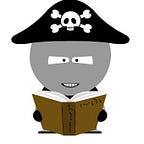Treasure Island
The appeal of Robert Louis Stevenson’s classic and the author’s Calvinistic obsession with dualities
“Fifteen men on a dead man’s chest — Yo-ho-ho, and a bottle of rum!” begins one of the most famous adventure stories of all time, Robert Louis Stevenson’s Treasure Island. The book became so popular it eventually spawned two well known films, the 1934 MGM version (where Wallace Beery played Long John Silver and Jackie Cooper was cast as Jim Hawkins) and perhaps the better 1950 Disney version (where Robert Newton played the squinting pirate with a parrot and Bobby Driscoll the wide-eyed young boy).
The novel began as a map Stevenson drew to amuse his stepson, Lloyd Osborne. The boy demanded a story to go with it, one that featured both treasure and an island, and Stevenson complied.
Treasure is an important ingredient in adventure stories beloved by the disenfranchised, by those too young to qualify for American Express cards. But there must be some risk. The young hero must acquire treasure from a forbidden place where some villain watches over it — whether the youngster be Peter Rabbit stealing vegetables from Mr. McGregor’s garden…
